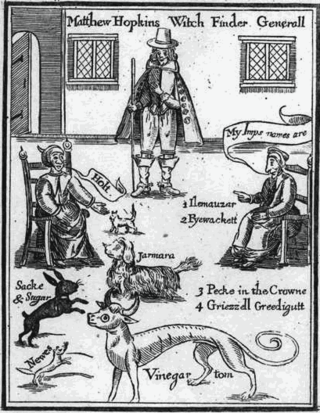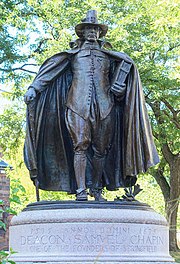
The Salem witch trials were a series of hearings and prosecutions of people accused of witchcraft in colonial Massachusetts between February 1692 and May 1693. More than 200 people were accused. Thirty people were found guilty, nineteen of whom were executed by hanging. One other man, Giles Corey, died under torture after refusing to enter a plea, and at least five people died in jail.
Margaret Mattson was one of two women tried and acquitted in Philadelphia in the Province of Pennsylvania for witchcraft in 1683.
Spectral evidence is a form of legal evidence based upon the testimony of those who claim to have experienced visions.
John Proctor, Jr. was a landowner in the Massachusetts Bay Colony. He was the son of John Proctor Sr. (1594–1672) and Martha Harper (1607–1667). John and his 3rd wife were tried on August 5, 1692. He was hanged on August 19, 1692 in Salem Village, Massachusetts Bay Colony during the Salem Witch Trials after being falsely accused and convicted of witchcraft.
Moll Dyer is the name of a legendary 17th-century resident of Leonardtown, Maryland, who is said to have been accused of witchcraft and chased out of her home by the local townsfolk on a winter night. Her body was allegedly found a few days later, partially frozen to a large stone.

Susannah Martin was one of fourteen women executed for the suspicion of practicing witchcraft during the Salem witch trials of colonial Massachusetts.

Ann Pudeator was a wealthy septuagenarian widow who was accused of and convicted of witchcraft in the Salem witch trials in colonial Massachusetts. She was executed by hanging.
This timeline of the Salem witch trials is a quick overview of the events.
Barbara Zdunk was an ethnically Polish alleged arsonist accused of witchcraft. Zdunk lived in the town of Rößel, in what was then East Prussia, and is now Reszel in Poland. She is considered by many to have been the last woman executed for witchcraft in Europe. Although, the accusations of witchcraft were listed in her case, witchcraft was not a criminal offense in Prussia at the time.

The trials of the Pendle witches in 1612 are among the most famous witch trials in English history, and some of the best recorded of the 17th century. The twelve accused lived in the area surrounding Pendle Hill in Lancashire, and were charged with the murders of ten people by the use of witchcraft. All but two were tried at Lancaster Assizes on 18–19 August 1612, along with the Samlesbury witches and others, in a series of trials that have become known as the Lancashire witch trials. One was tried at York Assizes on 27 July 1612, and another died in prison. Of the eleven who went to trial – nine women and two men – ten were found guilty and executed by hanging; one was found not guilty.
The St Osyth Witches is a common reference to the convictions for witchcraft near Essex in 1582. A village near Brightlingsea in Essex, St Osyth was home to 14 women who were put on trial for witchcraft, some of whom were duly convicted according to law.
Grace White Sherwood (1660–1740), called the Witch of Pungo, is the last person known to have been convicted of witchcraft in Virginia.
Anthony Upton (1656-1718) was an English-born judge, much of whose career was spent in Ireland. He was a close friend of the poet William King, who lived for a time at Mountown, Upton's country house near Dublin. Upton was accused by his critics of neglecting his official duties, but he showed a notably enlightened attitude at the Islandmagee witch trial of 1711, where he urged the jury, without success, to acquit the accused women. He was removed from the Bench in 1714, on account of his political affiliation, and returned to England, where he committed suicide for unknown reasons in 1718.
Mary Bliss Parsons (1628–1712) was an American woman who was accused of witchcraft, but was exonerated, in 17th-century Massachusetts.

Witchcraft in Orkney possibly has its roots in the settlement of Norsemen on the archipelago from the eighth century onwards. Until the early modern period magical powers were accepted as part of the general lifestyle, but witch-hunts began on the mainland of Scotland in about 1550, and the Scottish Witchcraft Act of 1563 made witchcraft or consultation with witches a crime punishable by death. One of the first Orcadians tried and executed for witchcraft was Allison Balfour, in 1594. Balfour, her elderly husband and two young children, were subjected to severe torture for two days to elicit a confession from her.
The witch trials in Connecticut, also sometimes referred to as the Hartford witch trials, occurred from 1647 to 1663. They were the first large-scale witch trials in the American colonies, predating the Salem Witch Trials by nearly thirty years. John M. Taylor lists a total of 37 cases, 11 of which resulted in executions. The execution of Alse Young of Windsor in the spring of 1647 was the beginning of the witch panic in the area, which would not come to an end until 1670 with the release of Katherine Harrison.

In England, witch trials were conducted from the 15th century until the 18th century. They are estimated to have resulted in the death of perhaps 500 people, 90 percent of whom were women. The witch hunt was at its most intense stage during the English Civil War (1642–1651) and the Puritan era of the mid-17th century.
Rebecca Fowler was a woman convicted and executed for witchcraft in 17th-century Maryland. Around a dozen witch trials were conducted in Maryland during the 17th and 18th centuries, with most being acquitted. Fowler is the only documented legal execution of an alleged witch in Maryland history.

During a 104-year period from 1626 to 1730, there are documented Virginia Witch Trials, hearings and prosecutions of people accused of witchcraft in Colonial Virginia. More than two dozen people are documented having been accused, including two men. Virginia was the first colony to have a formal accusation of witchcraft in 1626, and the first formal witch trial in 1641.
The views of witchcraft in North America have evolved through an interlinking history of cultural beliefs and interactions. These forces contribute to complex and evolving views of witchcraft. Today, North America hosts a diverse array of beliefs about witchcraft.








